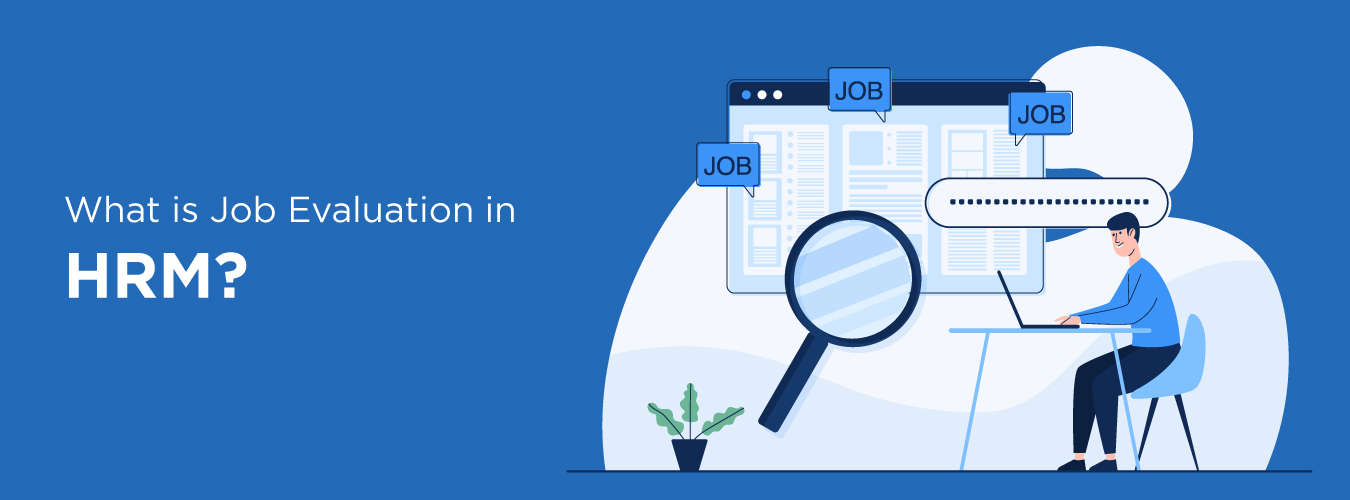What is job evaluation in HRM?
Job evaluation is a basic but significant function of human resource management (HRM). Every organization has a number of jobs and the goal of job evaluation is to compare jobs with each other in order to create a pay structure that is fair, equitable and consistent for everyone. The job evaluation process ensures that everyone is paid their worth. It also notes that different jobs have a varying level of entry and performance requirements. Essentially, job evaluation in HRM is the process of determining and quantifying the value of jobs.
Table of Contents
Job evaluation Process
The job evaluation process systematically scores and compares jobs along dimensions of job worth (effort, responsibility and complexity, importance, skills and working conditions of the job). It is a tool to compare jobs and classify them into appropriate pay ranges. The job evaluation process consists of job analysis, job descriptions and arriving at pay equity.
The job evaluation process ensures that the organization’s pay system is equitable, understandable, legally defensible, and competitive. Job evaluations are used to attract desirable candidates and retain high performing employees through fair and equitable pay scales.
Features of job evaluation
The main features of job evaluation are:
- It assesses job, not people
- It is an output of job analysis
- It provides the basis for wage negotiation based on facts
- Job evaluation does not design wage structure. Instead, it reduces the differences in wages and rationalizes the system.
- Job evaluation is performed by experts.
- Job evaluation determines the value of the job. Essentially every aspect of the job such as skill, responsibility levels in connection with the job.
- Job evaluation in HRM, helps improve employee productivity and employee satisfaction.
Objectives of job evaluation
Job evaluation determines the relative contributions that the performance of different jobs make towards the realization of organizational objectives. The objectives of job evaluation can be understood as:
- Wage and salary fixation: Wage and salary fixation is based on the relative contributions of different jobs and not on the basis of who the job holders are. Firstly, it is important to identify the likely contributions of different jobs. Job evaluation provides the information about the worth of a job based on its contribution to the achievement of organizational effectiveness.
- Restructuring job hierarchy: Job hierarchy is all about arranging different types of jobs in the order of their importance either in an ascending or descending manner. Job hierarchy can sometimes create problems because it is too lengthy and increases the number of levels in an organization. Essentially, organizations today prefer a flat structure to a tall one. Therefore, a job evaluation is preferred because it can reduce the number of job levels by merging closely related jobs together.
- Overcoming anomalies: When done periodically and objectively, job evaluation can overcome anomalies that develop in an organization over a period of time in compensation management. The following anomalies can be overcome by job evaluation:
- High wages being paid to people who hold positions that don’t require great skill, effort and responsibility.
- Paying beginners less than what they are entitled for as against what is required of them.
- Giving a raise to people whose performance does not justify the raise.
- Deciding the compensation based on seniority rather than ability.
- Paying varied wages for the same or closely related jobs and positions.
- Paying unequal salaries based on discrimination of race, sex, religion, or political differences.
Steps in the job evaluation process
Job evaluations follow the following steps:
- It reviews the choice of job evaluation methods such as job ranking, classification, factor comparison, and point factor analysis. It selects the most appropriate method to meet the needs of the organization.
- It gathers information on each job in the organization, analyses the job content to ensure that it is understandable and clear. The job content can be understood through questionnaires, job descriptions, interviews, and site visits.
- It must ensure that each job description enlists accountabilities and responsibilities. It can revise or expand job descriptions using the information collected.
- It will evaluate each position and link the ranked job to the organization’s existing compensation system or newly developed pay structure. A point system evaluates the skill, effort, responsibility and working conditions involved in the job. Then each of these factors can be further subdivided into sub factors that provide standards against which each job is rated and then its relative worth determined.
- It will create appropriate pay grades and pay ranges in the pay structure and set out employee progress within the range.
- Periodically, the job evaluation system is itself reviewed, evaluated, and modified resulting in compensation decisions.
Summary
The aim of job evaluation in HRM is to remove possible pay inequities. For instance, is an employee is being paid significantly more and given better benefits than someone in a similar role, then it is a pay inequity. Usually, job evaluation is done through a combination of internal assessment of the roles in the company and external market research.
People Also Ask:
1. What is job evaluation?
Job evaluation is the systematic process of determining the relative value of different jobs in an organization. The goal of job evaluation is to compare jobs with each other in order to create a pay structure that is fair, equitable, and consistent for everyone.
2. What is the main objective of job evaluation?
The main objective of job evaluation is to compare jobs with each other in order to create a pay structure that is fair, equitable, and consistent for everyone.
3. What are the 5 types of job evaluation methods?
The 5 Best Job Evaluation Methods
- Ranking Method. This job evaluation method works by ranking jobs according to their perceived value compared to other jobs.
- Grading/Classification Method.
- Point-Factor Method.
- Factor Comparison Method.
- Competitive Market Analysis Method.









